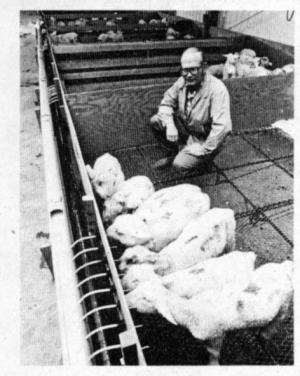1979 - Volume #3, Issue #2, Page #21
[ Sample Stories From This Issue | List of All Stories In This Issue | Print this story
| Read this issue]
Automatic Milk Feeder Saves Orphan Lambs
 |
Desertion of newborn lambs is common in sheeps flocks, and lambs are usually lost unless "adopted" by other milkproducing ewes. In any given year in the U.S. an estimated 3,600,000 lbs. of lamb never reach the market because orphaned lambs die.
The milk feeding device, which takes the place of the young lambs' mothers, consists of nipples and tubes attached to a metal bar mounted on a framework on each side of a 4-in, dia. plastic pipe. The pipe serves as a milk reservoir fed by gravity from a refrigerator bulk tank. Milk level is regulated by an electric control valve.
As many as 200 lambs can be fed with the milk feeder. Lambs should be penned in groups of 15 to 25 with one nipple for every three to five lambs. Milk may be mixed from milk replacer, or ewe's whole milk may be used. A smaller feeder is available for smaller numbers of lambs.
Kenneth R. Frederiksen and Walter L. Moden, agricultural scientists at the U.S. Sheep Experiment Station at Dubois, Idaho, say the devices have been so successful they are saving 90 to 95 percent of the orphan lambs in the station flock but that there are still changes to make in the device. They hope to perfect a fully automated system to prepare, store and dispense milk replacer.
At present there are no commercial manufacturers of the milk feeders, but sheep producers may be able to construct their own systems with common materials available.
Detailed drawings and descriptions are available by writing FARM SHOW Followup; Kenneth R. Frederiksen, U.S. Sheep Experiment Station, Dubois, Idaho 83423 (ph 208 374-5306).

Click here to download page story appeared in.

Click here to read entire issue
To read the rest of this story, download this issue below or click here to register with your account number.




